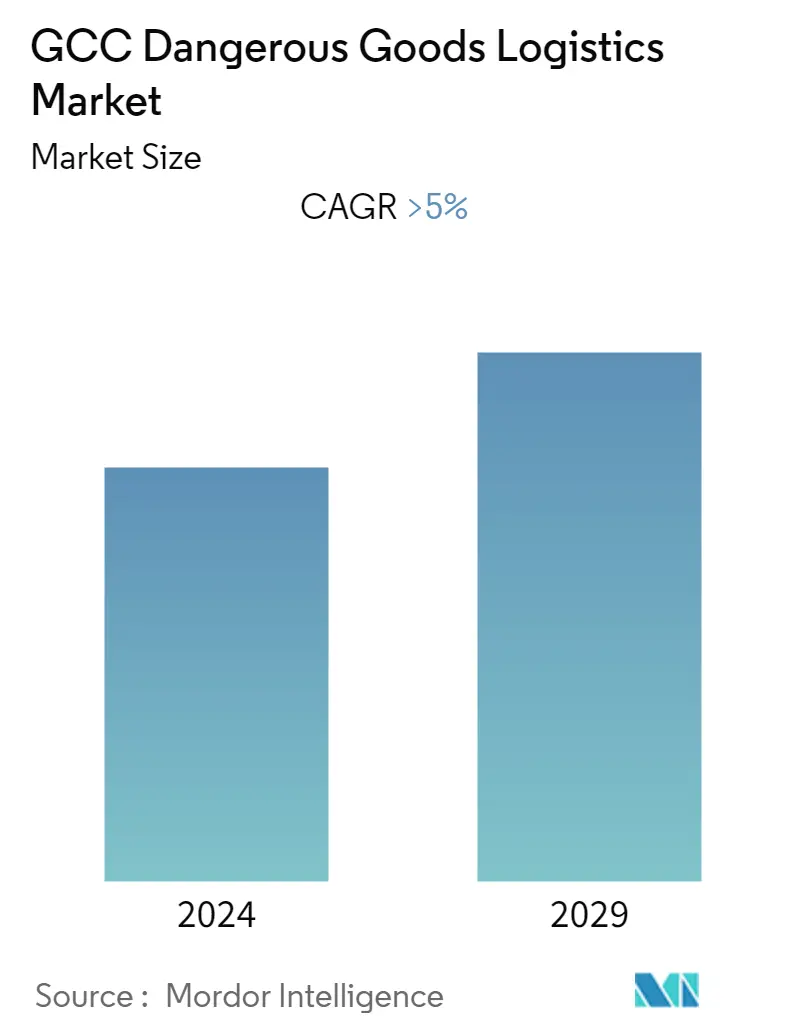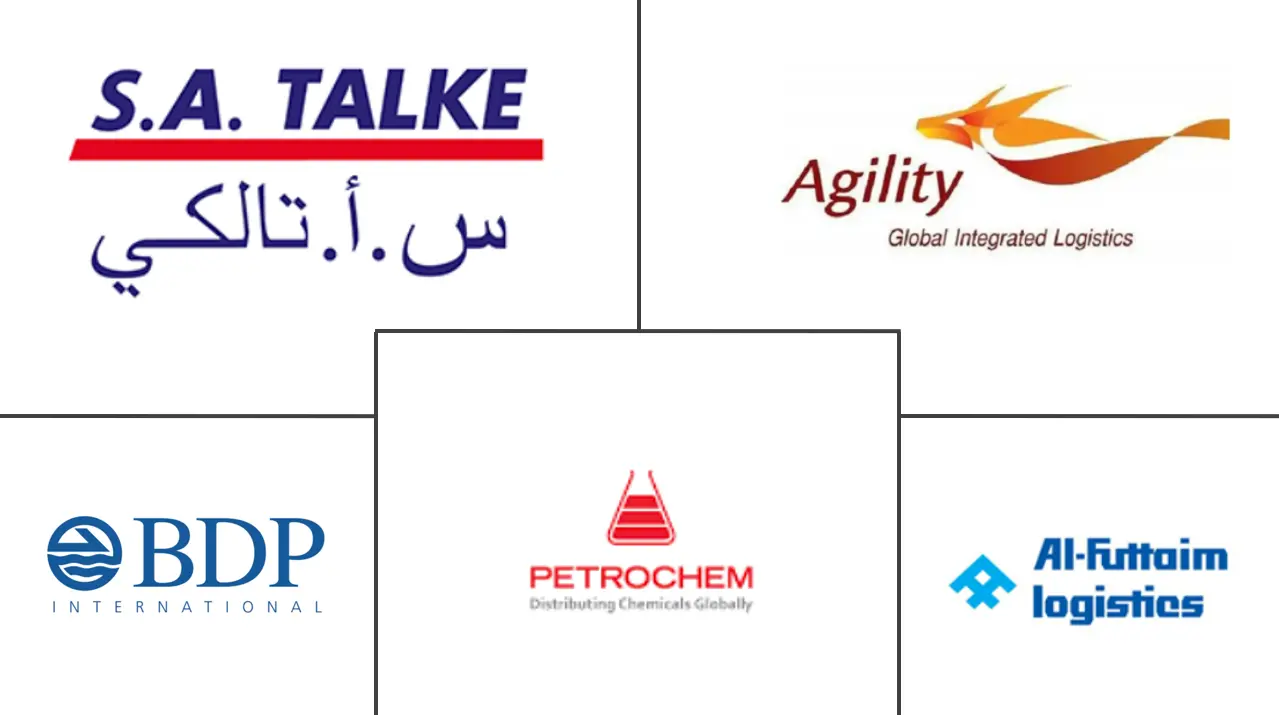Market Size of GCC Dangerous Goods Logistics Industry

| Study Period | 2020 - 2029 |
| Base Year For Estimation | 2023 |
| Forecast Data Period | 2024 - 2029 |
| Historical Data Period | 2020 - 2022 |
| CAGR | 5.00 % |
| Market Concentration | Low |
Major Players
*Disclaimer: Major Players sorted in no particular order |
GCC Dangerous Goods Logistics Market Analysis
The GCC Dangerous Goods Logistics market is expected to grow at a CAGR of more than 5% during the forecast period (2023-2028).
The COVID-19 pandemic fueled the growth of the dangerous goods logistics market. The increasing demand for medical oxygen in hospitals has resulted in a greater need for transportation. Furthermore, nuclear medicine, viral samples, healthcare hazardous substances, and clinical waste such as surgical equipment must be transported. Due to the lockdowns caused by the COVID-19 pandemic, the transportation of hazardous goods became easier and faster.
Aside from the fact that the rules for shipping dangerous goods are updated every year, the need to do so is also expected to grow every year. Between the growing need to ship lithium batteries and the already established gas and oil industries in the region, the market for dangerous goods is higher than it has ever been. This will increase the need for UN packaging, training, labels, and placards.
Digitization is the underlying solution to successfully transporting hazardous materials. In transportation operations, a digital supply network acts as a technology platform for inter-business processes and supply chain relationships. It connects suppliers, buyers, shippers, and third-party logistics providers, allowing them to better communicate, collaborate, and conduct business with each other. Manual processes like submitting a purchase order, acknowledging order acceptance, and confirming shipment are automated, with paper or email translated into appropriate formats where the document can be shared with others electronically.
GCC Dangerous Goods Logistics Industry Segmentation
Dangerous goods logistics involves providing services and solutions for the careful handling of dangerous goods (things that are explosive, flammable, toxic, infectious, or corrosive) and making sure that these goods can get to their markets without any problems.
The GCC Dangerous Goods Logistics market is segmented by service (transportation, warehousing and inventory management, and value-added services) and by country (Saudi Arabia, the United Arab Emirates, Kuwait, Oman, Bahrain, and Qatar). The report offers market size and forecast values in (USD) for all the above segments.
| By Service | |
| Transportation | |
| Warehousing and Inventory Management | |
| Value-added Services |
| By Country | |
| Saudi Arabia | |
| United Arab of Emirates | |
| Kuwait | |
| Qatar | |
| Bahrain | |
| Oman |
GCC Dangerous Goods Logistics Market Size Summary
The GCC Dangerous Goods Logistics market is experiencing significant growth, driven by the increasing demand for the transportation of hazardous materials such as medical oxygen, nuclear medicine, and clinical waste. The COVID-19 pandemic has accelerated this demand, highlighting the necessity for efficient logistics solutions in the region. The market is further bolstered by the established oil and gas industries, which require the transportation of lithium batteries and other dangerous goods. The evolving regulatory landscape and the need for compliance with updated shipping regulations are also contributing to the market's expansion. Digitization plays a crucial role in enhancing the efficiency of logistics operations, with digital supply networks facilitating better communication and collaboration among stakeholders.
The chemicals and petrochemicals industry in the GCC is poised for growth, supported by regional economic recovery and increased oil production, particularly in Saudi Arabia. The Kingdom's dominance in chemical output and its substantial investments in the sector are expected to drive the logistics industry forward. The oil and gas sector's robust performance, with significant capital expenditures and contracts, further underscores the region's economic potential. The GCC dangerous goods logistics market is characterized by a mix of international and local players, with companies like Agility, Petrochem, and BDP International leading the charge. As the market becomes more regulated, only those logistics providers with comprehensive capabilities and resources will thrive, ensuring the delivery of professional dangerous goods logistics services.
GCC Dangerous Goods Logistics Market Size - Table of Contents
-
1. MARKET INSIGHTS
-
1.1 Market Overview
-
1.2 Technological Snapshot and Digitalization
-
1.3 Regulations and Standards
-
1.4 Industry Value Chain/Supply Chain Analysis
-
1.5 Extent of Containerization in Dangerous Goods Transport Sector
-
1.6 Spotlight on Dangerous Goods Classes
-
1.7 Review and Commentary on Safety Standards and Potential Risk in Hazardous Goods Transport Sector
-
1.8 Impact of COVID-19 on the Market
-
-
2. MARKET SEGMENTATION
-
2.1 By Service
-
2.1.1 Transportation
-
2.1.2 Warehousing and Inventory Management
-
2.1.3 Value-added Services
-
-
2.2 By Country
-
2.2.1 Saudi Arabia
-
2.2.2 United Arab of Emirates
-
2.2.3 Kuwait
-
2.2.4 Qatar
-
2.2.5 Bahrain
-
2.2.6 Oman
-
-
GCC Dangerous Goods Logistics Market Size FAQs
What is the current GCC Dangerous Goods Logistics Market size?
The GCC Dangerous Goods Logistics Market is projected to register a CAGR of greater than 5% during the forecast period (2024-2029)
Who are the key players in GCC Dangerous Goods Logistics Market?
Agility, BDP INTERNATIONAL, Petrochem, Al Futtaim - Logistics and TALKE Group are the major companies operating in the GCC Dangerous Goods Logistics Market.

